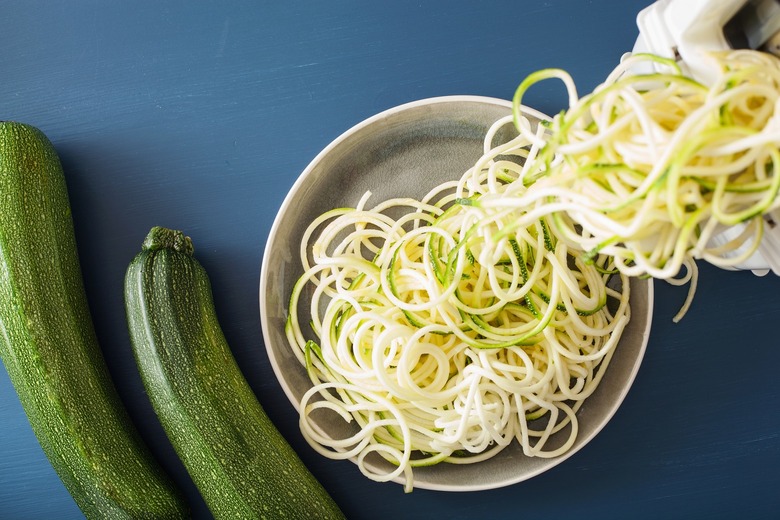The Problem With Zoodles
Walk into any large supermarket these days, and the first thing you will see, stacked tall and proud in the prepared produce section (just past the brightly colored flowers) will be a display case full of vegetable noodles. Oodles of zoodles sitting coolly upon the shelf, next to sweet potato, butternut squash, and beet variations. The popularity of these vegetable noodle-shaped pasta alternatives has positively skyrocketed over the past year, with fans of recently trendy low-carb diets (like the raw-vegan, paleo and keto diets) going absolutely bonkers for the pasta alternative. But zoodles need not be maligned by those who aren't necessarily on a particular diet or by the most ardent pasta purists, because when properly prepared, zoodles can be totally delicious.
The trouble begins, however, when cooks fail to take into consideration the vastly different makeup of vegetables compared to the flour-and-egg or -water compound that is pasta.
Vegetables are mostly water, and therefore less calorically dense than other food types (e.g., the food of the gods, pasta) which is what makes noodles made of vegetables particularly attractive to those who love a good spaghetti-with-tomato-sauce fork-twirling session but are trying to eat more vegetables, fewer calories, or fewer carbohydrates (though vegetables do still contain carbs, just less of them).
However, the most major gripe one may have with zoodles (let's focus on the zucchini-based O.G. of the veggie noodle kingdom for our purposes here) is that because of the much higher water content, a plateful of zoodles marinara can go from hot and delicious to soggy and disgusting a no time at all. The water within the zucchini seems to wait until you are comfortably sitting with fork in hand before deciding to advance, with military-like tactics, suddenly and silently, to the outer edges of your plate, where it pools tauntingly, turning your once Instagram-worthy #healthyeating #selflove #putthephonedownandjusteatit meal into a sad, swampy mess.
But things do not need to end so disastrously! There are certain measures one can take to help prevent watery zoodles from dampening your dinner.
Salt your zoodles.
One way to combat excess water is to salt your zucchini noodles before you use them. Lightly salt your zoodles with kosher salt (nothing fancy or too fine) and leave them for 10 to 15 minutes, sitting in a thin layer, (not in a dense pile) between some paper towels, like a paper-towel-zucchini sandwich.
The salt will draw out the moisture and the paper towel will absorb it, easy peasy! You may have to replace the paper towels once or twice, depending on how many zoodles you are making. For extra moisture removal, wrap the zoodles in a clean tea towel and squeeze out even more liquid — you might be surprised by how much there is!
Cook your zoodles.
A lot of people do this anyway, with many a recipe calling for zoodles to be lightly sautéed before eating. But not everyone does this (looking at you, raw-vegans — you guys should stick to the method above) and that can result in the aforementioned watery mess, with any kind of salt or acid that my be in the sauce, drawing out the water onto the plate.
By cooking the zoodles, you can get rid of some of the water by simply sautéing it away. Sautéing over high heat, making sure not to overcrowd the pan, is the best way to cook away unwanted moisture.
Make your sauce on the dry side.
This makes sense, right? If you anticipate that your sauce is going to be exposed to extra liquid, just make your sauce that much drier so that when everything is combined, it becomes the perfect consistency!
Use a bit of starch.
Cornstarch is another nifty way to get around the watery-zoodle predicament. Using cornstarch slurry, a technique common in Chinese cooking, can really help prevent watery sauces, by thickening the sauce and kind of stabilizing it (the water gets trapped as the starch expands). Whereas in the previous tip you are reducing the sauce, here you are adding a thickener (kind of like the difference between gravy and jus).
Make slurry by mixing two parts cold water with one part cornstarch (you will probably only need one to two tablespoons of it in total) and add it to a panful of zoodles that have been cooked, with the sauce already added. Then simply mix everything together and cook on a medium to low heat for about a minute until it has reached the desired consistency. Use a slurry sparingly, and be careful not to add too much! Only add a little at a time. You do not want to end up with a stiff, almost solid, glossy mixture!
This technique works best when making zoodle stir-fries, curries, and chunky vegetable heavy sauces.
If all else fails, turn to cheese.
Sometimes, even after correctly preparing zoodles, a little bit of moisture does present itself upon the plate, don't worry. Grated cheese, even non-dairy options, can cover a multitude of sins when it comes to a not-perfect plate of food. With something a bit watery, it can really help to bind everything together and create a more homogenous sauce, not to mention a more delicious one!
So there you have it: The problem with zoodles, plus five handy tips that might just save your meal. But please, don't give pasta the cold shoulder for too long. After all, it really is a wonderful food, and there are so many perfectly delicious pasta recipes for all occasions, right?
Daisy Nichols is the Cook editor at The Daily Meal. She is a pastafficionado who always expects the most from her zoodles. You can follow her on Instagram @bestbird.
